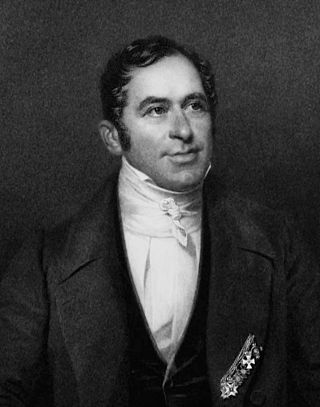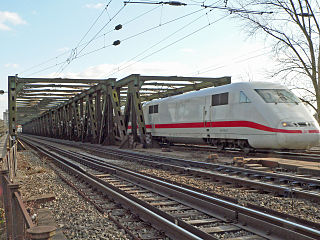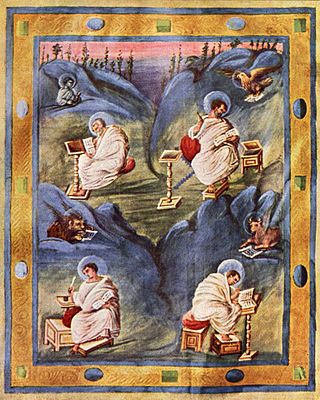
Boniface was an English Benedictine monk and leading figure in the Anglo-Saxon mission to the Germanic parts of Francia during the eighth century. He organised significant foundations of the church in Germany and was made bishop of Mainz by Pope Gregory III. He was martyred in Frisia in 754, along with 52 others, and his remains were returned to Fulda, where they rest in a sarcophagus which remains a site of Christian pilgrimage.

Fulda is a city in Hesse, Germany; it is located on the river Fulda and is the administrative seat of the Fulda district (Kreis). In 1990, the city hosted the 30th Hessentag state festival.

The Schuttern Gospels is an early 9th century illuminated Gospel Book that was produced at Schuttern Abbey in Baden. According to a colophon on folio 206v, the manuscript was written by the deacon Liutharius, at the order of his abbot, Bertricus.

Johann Lukas Schönlein was a German naturalist, and professor of medicine, born in Bamberg. He studied medicine at Landshut, Jena, Göttingen, and Würzburg. After teaching at Würzburg and Zurich, he was called to Berlin in 1839, where he taught therapeutics and pathology. He served as physician to Frederick William IV.

The Vienna Coronation Gospels, also known simply as the Coronation Gospels, is a late 8th century illuminated gospel book produced at the court of Charlemagne in Aachen. It was used by the future emperor at his coronation on Christmas Day 800, when he placed three fingers of his right hand on the first page of the Gospel of Saint John and took his oath. Traditionally, it is considered to be the same manuscript that was found in the tomb of Charlemagne when it was opened in the year 1000 by Emperor Otto III. The Coronation Evangeliar cover was created by Hans von Reutlingen, c. 1500. The Coronation Evangeliar is part of the Imperial Treasury (Schatzkammer) in the Hofburg Palace in Vienna, Austria.

The Hanover–Würzburg high-speed railway is a double-track, electrified high-speed railway between Hanover and Würzburg in Germany, 327 kilometres (203 mi) in length. The line, built between 1973 and 1991, was the longest contiguous new project constructed by Deutsche Bundesbahn. The total costs were almost DM 11.9 billion.

Heinrich von Bibra, Prince-Bishop, Prince-Abbot of Fulda (1711–1788) was Prince-Bishop and Prince-Abbot from 1759 to 1788. As part his role as Prince-Abbot of Fulda, he had the additional role as Archchancellor (Erzkanzler) of the Holy Roman Empress.

The House of Bibra was one of the leading Uradel families in Franconia and present day Thuringia from the mid-15th century to about 1600. Later on the family rose from Reichsritter to Reichsfreiherr. After the Holy Roman Empire dissolved, they were made ‘’Freiherr’‘ (Barons) of Bavaria and Bohemia.

Fulda station is an important transport hub of the German railway network in the east Hessian city of Fulda. It is used by about 20,000 travellers each day. It is classified by Deutsche Bahn as a category 2 station. It is a stop for Intercity-Express, Intercity services and regional services. The original station was opened as part of the Frankfurt–Bebra railway in 1866. This was destroyed during the Second World War and rebuilt after the war. The station was adapted in the 1980s for the Hanover–Würzburg high-speed railway.
Candidus (Bruun) of Fulda was a Benedictine scholar of the ninth-century Carolingian Renaissance, a student of Einhard, and author of the vita of his abbot at Fulda, Eigil.

Codex Rehdigerianus designated by l or by 11, is a medieval Latin manuscript written on parchment, which was held in the city library of Breslau. The manuscript is attributed to Cassiodorus II of St. Elisabeth's Church, Breslau. The Codex was named after Thomas Rehdiger, an antiquary from Śląsko, who was the patron of Vulcanius. The manuscript was edited and published in 1913. Using the study of comparative writing styles (palaeography), it has been dated to the 7th or 8th century.

The Witch trials of Fulda in Germany from 1603 to 1606 resulted in the death of about 250 people. They were one of the four largest witch trials in Germany, along with the Trier witch trials, the Würzburg witch trial, and the Bamberg witch trials. The persecutions were ordered by the Catholic Prince Bishop, a follower of the Counter-Reformation. Crypto-protestants were executed on charges of witchcraft.
The Garland of Howth, also known as the Codex Usserianus Secundus, designated by r2 or 28, is a fragmentary 8th to 10th century Latin Gospel Book in the possession of Trinity College Dublin as MS. 56.

These DB Class V 100 diesel locomotives were produced in the late 1950s by the Deutsche Bundesbahn for non-electrified branch lines as a replacement for steam locomotives. The V 100 class was built in three different variants.
The Codex M. p. th. f. 67, designated by 11A, is an 8th or 9th century Latin Gospel Book. The text, written on vellum, it was known as a manuscript of Vulgate. The manuscript contains the text of the four Gospels on 192 parchment leaves. It is written in two columns per page, 20 lines per column. It contains prolegomena to the Gospels.

The Frankfurt–Göttingen railway is a continuously double track and electrified main line in Hesse and southern Lower Saxony, Germany. The line was initially built from Bebra towards Fulda by the Kurhessen State Railway. After the Prussian annexation of the Electorate of Hesse as a result of the Austro-Prussian War of 1866, it was completed to Frankfurt as the Frankfurt-Bebra Railway. The line was later extended from Bebra to Göttingen.

The Aachen Gospels are a Carolingian illuminated manuscript which was created at the beginning of the ninth century by a member of the Ada School. The Evangeliary belongs to a manuscript group which is referred to as the Ada Group or Group of the Vienna Coronation Gospels. It is part of the church treasury of Charlemagne's Palatine Chapel, now Aachen Cathedral, and is today kept in the Aachen Cathedral Treasury. The Treasury Gospels and the more recent Ottonian Liuthar Gospels are the two most significant medieval manuscripts on display there.

The Universitätsbibliothek Würzburg is the central library of the Julius-Maximilians-Universität Würzburg. As a regional library of Lower Franconia, it collects Lower Franconian literature. The Universitätsbibliothek Würzburg is maintained by the Free State of Bavaria. With 3.6 million media, it is one of the largest libraries in Bavaria.















